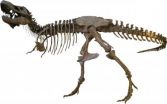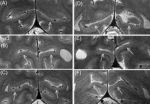(Press-News.org) The ferocious Tyrannosaurus rex has been depicted as the top dog of the Cretaceous, ruthlessly stalking herds of duck-billed dinosaurs and claiming the role of apex predator, much as the lion reigns supreme in the African veld.
But a new census of all dinosaur skeletons unearthed over a large area of eastern Montana shows that Tyrannosaurus was too numerous to have subsisted solely on the dinosaurs it tracked and killed with its scythe-like teeth.
Instead, argue paleontologists John "Jack" Horner from the Museum of the Rockies and Mark B. Goodwin from the University of California, Berkeley, T. rex was probably an opportunistic predator, like the hyena in Africa today, subsisting on both carrion and fresh-killed prey and exploiting a variety of animals, not just large grazers.
"In our census, T. rex came out very high, equivalent in numbers to Edmontosaurus, which many people had thought was its primary prey," said Horner, curator of paleontology at the Museum of the Rockies in Bozeman, Mont., and Regents Professor at Montana State University. "This says that T. rex is not a cheetah, it's not a lion. It's more like a hyena."
"This putative apex predator is as abundant in the upper layers of the Hell Creek Formation as the herbivores, its reputed primary food source," added Goodwin, a curator in UC Berkeley's Museum of Paleontology and assistant director of the museum. "And it's even more plentiful in the other two-thirds of the formation. This supports the view that T. rex benefited from a much wider variety of food sources than live prey."
The dinosaur census in the Hell Creek Formation of Montana, which dates from 65-95 million years ago, was begun in 1999 by Horner and Goodwin with the financial and occasional field support of Nathan Myhrvold, former chief technology officer for Microsoft Corp. and co-founder of Intellectual Ventures of Bellevue, Wash. The results, authored by Horner, Goodwin and Myhrvold, were published Feb. 9 in the open-access journal PLoS ONE.
Normally, Goodwin said, top predators are one-third or one-fourth as abundant as their prey, because of the larger energy needs of carnivores. Opportunistic hunters like the hyena, however, can be twice as abundant as the top predators.
"If you count the lions and the leopards and the cheetahs in the Serengeti, the number still does not equal the number of hyenas, because hyenas have a much wider food source," Horner said. "Cheetahs, for example, only go after things that are really fast. They don't eat turtles. But a hyena will eat a turtle, or anything else that it can catch or is dead."
Similarly, T. rex was eating anything it could, he said. "There's no evidence that T. rex could run very fast, so it wasn't out there being a cheetah. If it could get a sick animal, it would."
Horner suggests that juvenile and young adult T. rex may have been primarily flesh eaters, while the older adults, which developed proportionally larger, bone-crushing teeth as they aged, also consumed the bones and marrow of their prey.
Horner and Goodwin, together and separately, have been digging for dinosaurs in Eastern Montana for decades. The fossils date from a time when the area bordered an inland sea, which periodically advanced and withdrew over coastal plains, depositing sediment that was later exposed and heavily eroded. When Horner started his census of dinosaurs in the Hell Creek Formation around Fort Peck Lake in 1999, he teamed up with Goodwin to re-examine some of the dinosaurs discovered in the area.
Since then, through lab analysis and annual summer digs, they have shown that one named species, Torosaurus, was just a big, aged Triceratops; two dome-headed dinosaurs, Dracorex and Stygimoloch, were merely younger members of the genus Pachycephalosaurus; and the so-called Nanotyrannus was just a juvenile T. rex.
Once these fossils had been properly identified, Homer and Goodwin were able to catalog the species and relative ages of known dinosaurs in the formation, which is about 100 meters thick at exposed areas covering some 1,000 square kilometers. The census included only skeletal remains, not teeth, because the paleontologists wanted a record of the maturity of each specimen, and teeth tell little about the age of a dinosaur at death, Goodwin said.
Collating only skeletons containing three or more bones, the researchers counted 23 Triceratops, five Tyrannosaurus and five Edmontosaurus within the Upper Hell Creek Formation. The youngest or "upper" formation dates from between 65 and 70 million years ago, just before the purported mass extinction of the dinosaurs that was attributed to a comet or asteroid impact.
A census of older sediments – the lower Hell Creek formation – turned up 11 Triceratops, 11 T. rex and six Edmontosaurus partial skeletons, along with fossil bones of three other dinosaurs: Thescelosaurus and Ornithomimus, two bird-like, bipedal meat-eaters reaching some 12 feet in length at maturity; and Ankylosaurus, an armored, four-legged plant-eater with a club tail.
"Small juveniles and older adults were relatively rare compared to large juveniles and subadults for all the dinosaurs," Goodwin said. This could be explained if juveniles lived in other locations, which is not uncommon in some species. The largest adults may simply have been relatively rare.
"This adds to an emerging picture of what the dinosaur fauna looked like during the late Cretaceous," he said.
Horner noted the greater variety of dinosaurs in the older sediments, the Lower Hell Creek Formation, compared to the younger "Upper" formation.
"Definitely there was a change in population leading up to the Cretaceous-Tertiary boundary, so something was happening to the faunas prior to the impact," he said. "During the 10 million years after dinosaur diversity peaked 75 million years ago, the dinosaurs dwindled pretty fast, and there weren't many left at the end."
INFORMATION:
The work was supported by individual donations from James Kinsey, Catherine B. Reynolds and Homer Hickam, as well as Intellectual Ventures, the Windway Foundation, the Smithsonian Institution and the University of California Museum of Paleontology.
T. rex more hyena than lion
Tyrannosaurus rex was an opportunistic feeder, not a top predator, paleontologists say
2011-02-24
ELSE PRESS RELEASES FROM THIS DATE:
Researchers discover new way to design metal nanoparticle catalysts
2011-02-24
Tiny metal nanoparticles are used as catalysts in many reactions, from refining chemicals to producing polymers and biofuels. How well these nanoparticles perform as catalysts for these reactions depend on which of their crystal faces are exposed.
But previous attempts to design these nanoparticles by changing their shape have failed because the structures are unstable and will revert back to their equilibrium shape.
Now, researchers at Northwestern University's Institute for Catalysis in Energy Processing have discovered a new strategy for fabricating metal nanoparticles ...
Crying baby draws blunted response in depressed mom's brain
2011-02-24
EUGENE, Ore. -- Mothers who are depressed respond differently to their crying babies than do non-depressed moms. In fact, their reaction, according to brain scans at the University of Oregon, is much more muted than the robust brain activity in non-depressed moms.
An infant crying is normal, but how mothers respond can affect a child's development, says Jennifer C. Ablow, professor of psychology. For years, Ablow has studied the relationship of behavior and physiological responses such as heart rate and respiration of mothers, both depressed and not, when they respond ...
Therapeutic lifestyle changes as useful as drugs in improving mental health
2011-02-24
Irvine, Calif., Feb. 22, 2011 — Getting more exercise, spending time outdoors and helping others are among the activities that can be as effective as drugs or counseling in treating an array of mental illnesses, including depression and anxiety, according to a UC Irvine study.
In determining this, Dr. Roger Walsh, professor of psychiatry & human behavior, philosophy and anthropology, as well as adjunct professor of religious studies, reviewed research on the effects of what he calls "therapeutic lifestyle changes." Other TLCs might relate to nutrition, relationships, ...
USDA study confirms links between longer ragweed season and climate change
2011-02-24
This release is available in Spanish.
WASHINGTON--Studies by a U.S. Department of Agriculture (USDA) scientist and cooperators have confirmed what many pollen-sensitive people already suspected: In some parts of North America, ragweed season now lasts longer and ends later.
Ragweed pollen in some parts of the northern United States and Canada now lingers almost a month longer than it did in 1995, and these increases are correlated to seasonal warming shifts linked to climate change dynamics in the higher latitudes, according to a study published Monday in the Proceedings ...
A nano-solution to global water problem: Nanomembranes could filter bacteria
2011-02-24
BUFFALO, N.Y. -- New nanomaterials research from the University at Buffalo could lead to new solutions for an age-old public health problem: how to separate bacteria from drinking water.
To the naked eye, both water molecules and germs are invisible -- objects so tiny they are measured by the nanometer, a unit of length about 100,000 times thinner than the width of a human hair.
But at the microscopic level, the two actually differ greatly in size. A single water molecule is less than a nanometer wide, while some of the most diminutive bacteria are a couple hundred.
Working ...
The blind also have a Stripe of Gennari
2011-02-24
This release is available in German.
The Stripe of Gennari develops even in those who are blind from birth and does not degenerate, despite a lack of visual input. This was discovered by Robert Trampel and colleagues from the Max Planck Institute for Human Cognitive and Brain Sciences using magnetic resonance imaging. This bundle of nerve fibers, which is approximately 0.3 mm thick, is not exclusively responsible for optic information. In the blind, it might play a greater role in processing tactile stimuli. This could contribute to an enhanced sense of touch and support ...
Feb. 23 NASA mission to tote $28 million CU-Boulder instrument and tiny student satellite
2011-02-24
A $28 million University of Colorado Boulder instrument developed to study changes in the sun's brightness and its impact on Earth's climate is one of two primary payloads on NASA's Glory mission set to launch from Vandenberg Air Force Base in California on Feb. 23.
Designed and built by a team from CU-Boulder's Laboratory for Atmospheric and Space Physics, the instrument called the Total Irradiance Monitor, or TIM, will point directly toward the sun to measure both short- and long-term fluctuations in the sun's energy output as it reaches the top of Earth's atmosphere. ...
Study suggests gender does not play a role in risk of death from heart attack
2011-02-24
ANN ARBOR, Mich. – A study led by the University of Michigan Cardiovascular Center shows being a woman may not increase your risk of dying from treatment for a severe heart attack.
U-M researchers and colleagues in the Michigan Cardiovascular Consortium found women who received treatment such as an angioplasty had higher unadjusted in-hospital heart attack deaths.
But these differences appear to be related to women's ages and additional health problems – not gender, says study lead author Elizabeth Jackson, M.D., M.P.H., an assistant professor of internal medicine ...
Nanoparticles increase survival after blood loss
2011-02-24
February 22, 2011 — (BRONX, NY) — In an advance that could improve battlefield and trauma care, scientists at Albert Einstein College of Medicine of Yeshiva University have used tiny particles called nanoparticles to improve survival after life-threatening blood loss. Nanoparticles containing nitric oxide (NO) were infused into the bloodstream of hamsters, where they helped maintain blood circulation and protect vital organs. The research was reported in the February 21 online edition of the journal Resuscitation.
"The new nanomedicine was developed to address the need ...
E-health must be a priority, researchers say
2011-02-24
An electronic health record system should be the backbone of health care reform in Canada and more must be done to speed up the implementation of this initiative across the country. Furthermore for this system to be put in place effectively, doctors and front line health care workers and administrators must be encouraged to play a more active role. These are the findings of an innovative new study assessing the effectiveness Canada Health Infoway's e-health plan. The study, which was conducted by scientists at the Research Institute of the McGill University Health Centre ...
LAST 30 PRESS RELEASES:
Innovative techniques enable Italy’s first imaging of individual trapped atoms
KIER successfully develops Korea-made “calibration thermoelectric module” for measuring thermoelectric device performance
Diversifying US Midwest farming for stability and resilience
Emphasizing immigrants’ deservingness shifts attitudes
Japanese eels, climate change, and river temperature
Pusan National University researchers discover faster, smarter heat treatment for lightweight magnesium metals
China’s 2024 Gastroenterology Report: marked progress in endoscopy quality and disease management
Pusan National University researchers uncover scalable method for ultrahigh-resolution quantum dot displays
Researchers use robotics to find potential new antibiotic among hundreds of metal complexes
Gut bacteria changes at the earliest stages of inflammatory bowel disease
Scientists develop new way to “listen in” on the brain’s hidden language
Brain research: “Pulse generators” grow and shrink as memories are formed
For teens, any cannabis use may have impact on emotional health, academic performance
School meals could unlock major gains for human and planetary health
Menopause hormone therapy does not appear to impact dementia risk
Signature patterns of brain activity may help predict recovery from traumatic brain injury
Dresden study uncovers new key mechanism in cancer cells
New species are now being discovered faster than ever before, study suggests
Cannabis-based products show limited short-term benefit for chronic pain, with increased risk of adverse effects
Cannabis products with more THC slightly reduce pain but cause more side effects
Clearing the brain of aging cells could aid epilepsy and reduce seizures
Brain injuries linked with potential risk of suicide, new study finds
New technique lights up where drugs go in the body, cell by cell
New study finds movement of fishing fleets can reveal shifts in marine ecosystems
Embargoed: New evidence points to potential treatment for vascular dementia
Study uncovers disrupted brain balance in alcohol dependence
Working in groups can help Republicans and Democrats agree on controversial content moderation online
Structural findings reveal how distinct GPCR ligands create different levels of activation
Anything-goes “anyons” may be at the root of surprising quantum experiments
UC review: Maximizing workplace opportunity for veterans
[Press-News.org] T. rex more hyena than lionTyrannosaurus rex was an opportunistic feeder, not a top predator, paleontologists say



